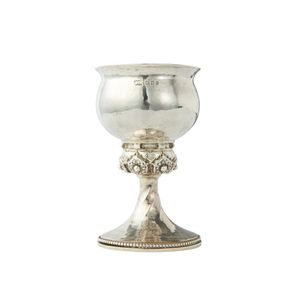Omar Ramsden Hand-Beaten Silver Chalice
You must be a subscriber, and be logged in to view price and dealer details.
Subscribe Now to view actual auction price for this item
When you subscribe, you have the option of setting the currency in which to display prices to $Au, $US, $NZ or Stg.
- Sterling Silver - Sterling silver is a mixture of 92.5% pure silver and 7.5% of another metal, usually copper. Fine silver is 99.9% pure silver, and is relatively soft and the addition of the very small amount of copper gives the metal enough strength and hardness to be worked into jewellery, decorative and household objects.
- Circa - A Latin term meaning 'about', often used in the antique trade to give an approximate date for the piece, usually considered to be five years on either side of the circa year. Thus, circa 1900 means the piece was made about 1900, probably between 1895 and 1905. The expression is sometimes abbreviated to c.1900.
- Engraving - The method of decorating or creating inscriptions on silver and other metal objects by marking the surface with a sharp instrument such as a diamond point or rotating cutting wheel.
- Chalice - A chalice is a large cup or goblet that is used in religious ceremonies, particularly in Christian liturgical traditions. It is typically made of precious metal such as gold or silver, and is used to hold wine during the Eucharist, which is the central sacrament of the Christian Church. The chalice is also called the "cup of salvation" and is a symbol of Jesus' sacrifice on the cross.
In the Christian tradition, the chalice is a symbol of the blood of Jesus Christ, which is offered to the faithful as a means of grace and salvation. The chalice is used to hold the wine that is consecrated during the Eucharist and is considered to be a sacred object.
In the liturgical celebration of the Eucharist, it's passed around to the faithful, and the believer drinks from it to partake in the sacrament. Chalices are also used in other liturgical celebrations such as baptism, confirmation and anointing of the sick.
Chalices come in different shapes and sizes, from simple cups to highly ornate and decorative vessels, some of them are adorned with precious stones and intricate engravings. Chalices can also be used for other purposes, such as for holding holy water for baptism, or for the distribution of ashes on Ash Wednesday. - Everted - An everted rim is an outwardly turning or flaring outwards rim, as seen the rims on jugs, vases, bowls and dishes.
This item has been included into following indexes:
Visually similar items

A Charles I sterling silver goblet with a later Inscription, maker's mark Rubbed / London /, circa 1631, the ogee body centred by a cartouche bearing the inscription 'Presented to / Richard Hubbard / under 20 Years of Age / as the best of the Ploughers / a

Chalice / goblet. By silversmiths Samuel Hayne and Dudley Cater Presented to Mr Andrew Torning sterling silver London 1856, circa 1857. Height 20.5 cm

A George III sterling silver chalice William & Patrick Cunningham / Edinburgh /, circa 1816-17, campagna in form, with acanthus leaf motif to lower body, raised on a gadrooned edge waist, above on a fluted base with a beaded border, approximately 556 gms s

Bendigo Majolica urn. Classic form, height 45 cm, diameter 30 cm
